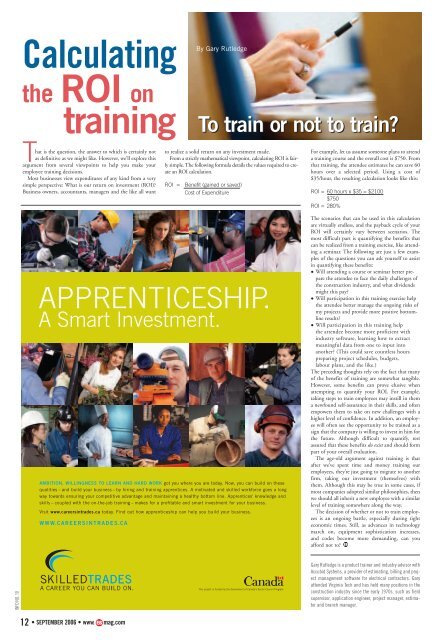September 2006.pdf - Electrical Business Magazine
September 2006.pdf - Electrical Business Magazine
September 2006.pdf - Electrical Business Magazine
You also want an ePaper? Increase the reach of your titles
YUMPU automatically turns print PDFs into web optimized ePapers that Google loves.
Calculating<br />
By Gary Rutledge<br />
the ROI on<br />
training<br />
That is the question, the answer to which is certainly not<br />
as definitive as we might like. However, we’ll explore this<br />
argument from several viewpoints to help you make your<br />
employee training decisions.<br />
Most businesses view expenditures of any kind from a very<br />
simple perspective: What is our return on investment (ROI)<br />
<strong>Business</strong> owners, accountants, managers and the like all want<br />
To train or not to train<br />
to realize a solid return on any investment made.<br />
From a strictly mathematical viewpoint, calculating ROI is fairly<br />
simple. The following formula details the values required to create<br />
an ROI calculation.<br />
ROI = Benefit (gained or saved)<br />
Cost of Expenditure<br />
For example, let us assume someone plans to attend<br />
a training course and the overall cost is $750. From<br />
that training, the attendee estimates he can save 60<br />
hours over a selected period. Using a cost of<br />
$35/hour, the resulting calculation looks like this:<br />
ROI = 60 hours x $35 = $2100<br />
$750<br />
ROI = 280%<br />
APPRENTICESHIP.<br />
A Smart Investment.<br />
AMBITION, WILLINGNESS TO LEARN AND HARD WORK got you where you are today. Now, you can build on these<br />
qualities – and build your business – by hiring and training apprentices. A motivated and skilled workforce goes a long<br />
way towards ensuring your competitive advantage and maintaining a healthy bottom line. Apprentices’ knowledge and<br />
skills – coupled with the on-the-job training – makes for a profitable and smart investment for your business.<br />
Visit www.careersintrades.ca today. Find out how apprenticeship can help you build your business.<br />
WWW.CAREERSINTRADES.CA<br />
The scenarios that can be used in this calculation<br />
are virtually endless, and the payback cycle of your<br />
ROI will certainly vary between scenarios. The<br />
most difficult part is quantifying the benefits that<br />
can be realized from a training exercise, like attending<br />
a seminar. The following are just a few examples<br />
of the questions you can ask yourself to assist<br />
in quantifying these benefits:<br />
• Will attending a course or seminar better prepare<br />
the attendee to face the daily challenges of<br />
the construction industry, and what dividends<br />
might this pay<br />
• Will participation in this training exercise help<br />
the attendee better manage the ongoing risks of<br />
my projects and provide more positive bottomline<br />
results<br />
• Will participation in this training help<br />
the attendee become more proficient with<br />
industry software, learning how to extract<br />
meaningful data from one to input into<br />
another (This could save countless hours<br />
preparing project schedules, budgets,<br />
labour plans, and the like.)<br />
The preceding thoughts rely on the fact that many<br />
of the benefits of training are somewhat tangible.<br />
However, some benefits can prove elusive when<br />
attempting to quantify your ROI. For example,<br />
taking steps to train employees may instill in them<br />
a newfound self-assurance in their skills, and often<br />
empowers them to take on new challenges with a<br />
higher level of confidence. In addition, an employee<br />
will often see the opportunity to be trained as a<br />
sign that the company is willing to invest in him for<br />
the future. Although difficult to quantify, rest<br />
assured that these benefits do exist and should form<br />
part of your overall evaluation.<br />
The age-old argument against training is that<br />
after we’ve spent time and money training our<br />
employees, they’re just going to migrate to another<br />
firm, taking our investment (themselves) with<br />
them. Although this may be true in some cases, if<br />
most companies adopted similar philosophies, then<br />
we should all inherit a new employee with a similar<br />
level of training somewhere along the way.<br />
The decision of whether or not to train employees<br />
is an ongoing battle, especially during tight<br />
economic times. Still, as advances in technology<br />
march on, equipment sophistication increases,<br />
and codes become more demanding, can you<br />
afford not to<br />
INFO NO. 10<br />
This project is funded by the Government of Canada’s Sector Council Program.<br />
Gary Rutledge is a product trainer and industry advisor with<br />
Accubid Systems, a provider of estimating, billing and project<br />
management software for electrical contractors. Gary<br />
attended Virginia Tech and has held many positions in the<br />
construction industry since the early 1970s, such as field<br />
supervisor, application engineer, project manager, estimator<br />
and branch manager.<br />
12 • SEPTEMBER 2006 • www. mag.com

















